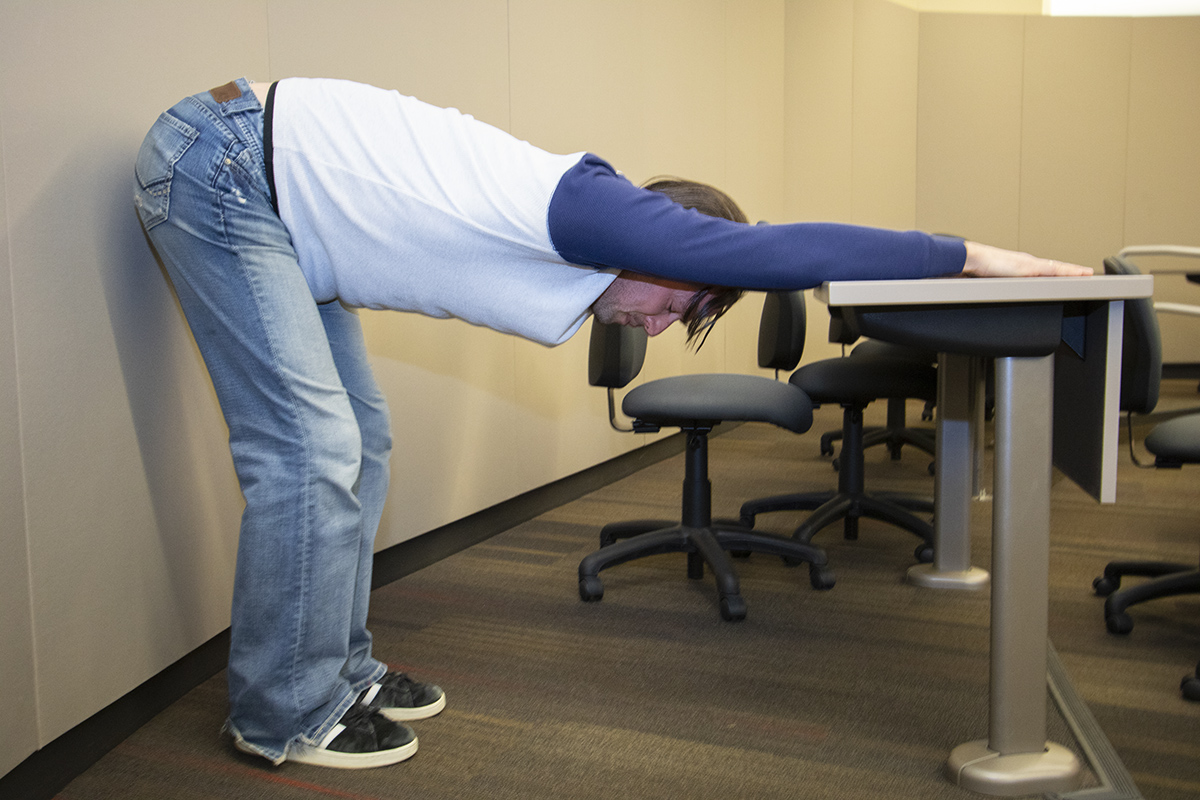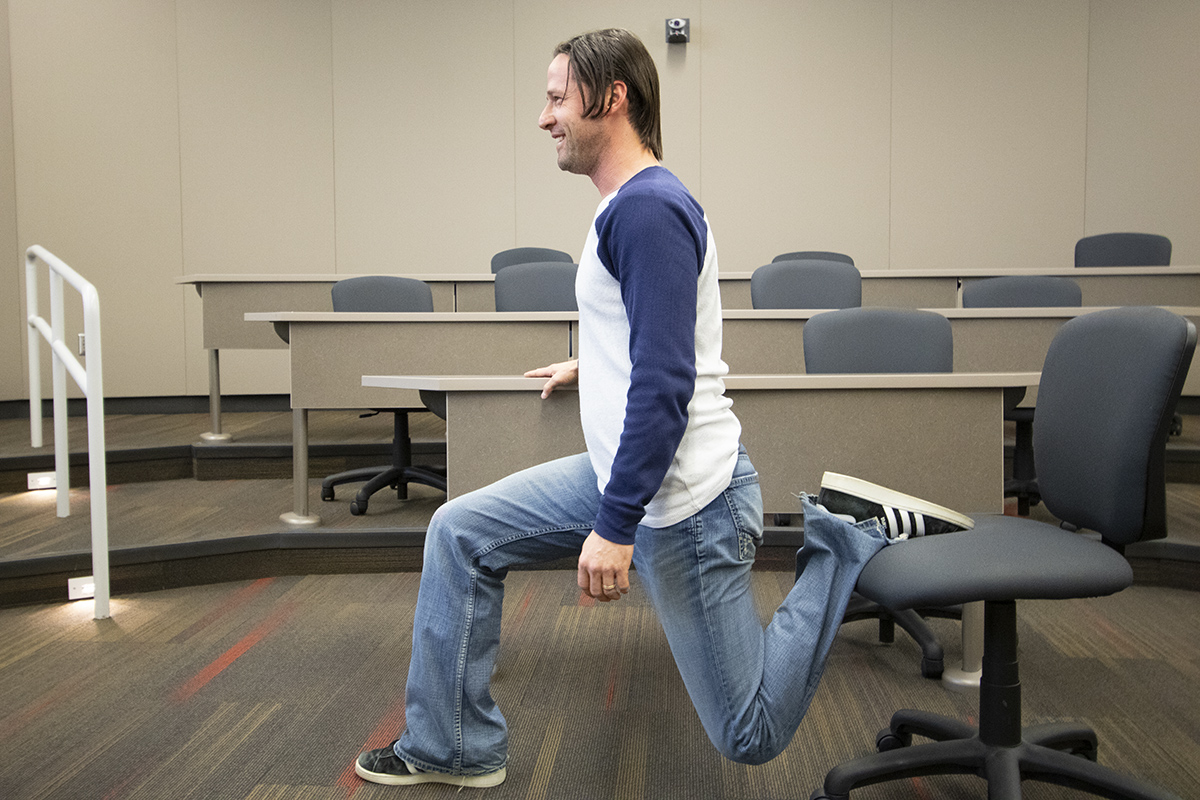Working Out at Work
Busy work schedules can sometimes make it hard to pay attention to your health. Hitting the gym over lunch or after work takes time and planning, and even the most iron-willed among us have trouble saying “no” when a co-worker brings donuts for the whole office. But when you look at the numbers — most working Americans spend 21 hours a day sedentary, leaving just three hours of physical activity, and less than one-third of adults get the recommended 30 minutes of structured exercise five times a week — the need to practice good health habits at work takes on vital importance.
“There’s a saying out there that sitting is the new smoking, because the lack of physical activity throughout people's days is just as detrimental to their health as if they were walking out and having a smoke break hourly,” Ashley Herda, assistant professor in the Department of Health, Sport and Exercise Sciences at the KU Edwards Campus, says. “There's negative cardiovascular implications where there's rigidity of the arteries. Coupled with poor diet, which most Americans tend to follow, they can have plaque buildup in the arteries, and that leads to more cardiovascular complications.”
Herda says that plaque buildup in the arteries isn’t the only issue that arises from a sedentary lifestyle. “There's also implications on the lack of physical activity and being able to maintain stable glucose levels. The lack of stabilization, or roller coaster of influx and drops, leads to diabetes. Physical activity helps maintain a stable blood glucose,” Herd says. “It's always more than one thing going on.”

The long-term risks of sitting all day are serious. Fortunately, there are easy ways to work a little physical activity into your workday, according to Herda and Jordan Taylor, academic program associate for Health, Sport and Exercise Sciences. The KU Edwards Campus’ exercise science programs focus on the study of human movement, using elements of biological, physical and health science.
The goal of adding movement to your day, Taylor says, is to stretch out muscles that are not properly used while you sit. “You’re sitting there typing all day, your shoulders are elevated, they’re internally rotated, your chest gets tight,” Taylor says. “So, you’re trying to do the opposite with those stretches— lengthen out your muscles that have been shortened.”
Here are a few suggestions from Herda and Taylor for easy physical activities to help lessen the effects of a sedentary lifestyle.
Take a “restorative break”
Herda says getting up for 10 to 15 minutes every hour and a half (called a restorative break) can help introduce activity into your day and break up all that time spent at your desk.

“It's beneficial for your mentality. A lot of people might say if I work eight hours, and I take 10 minutes every hour, that's 80 minutes of my day that I'm wasting, because I’m not working, but that’s not necessarily true.”
To the contrary, in fact — Taylor says regular breaks can actually help you work smarter. “Sometimes, that break can also increase productivity, but people don’t think of it that way,” he says. If the timing of a regular break isn’t an option, Taylor suggests finding ways to naturally incorporate standing or walking into your work routine. “Try getting a desk that you can stand at, or, if you have the office space, getting a treadmill that you can walk on while you work.”
Substitute screen time for face time
Herda says another way to battle the side effects of a sedentary job are short walks, even if it’s just across the office. “Try setting a timer and taking hourly walks, even if it's only five to 10 minutes,” Herda says. “Just get up, walk to the bathroom, walk to the water cooler.”
Taylor says he does this by trying to talk to his colleagues in person whenever possible, rather than sending an email. “Sometimes, for me, just to get up and out of my chair instead of sending an email or an instant message is helpful,” he says. “I'll walk over and see them, just to get my blood going.”

Stretch it out
Don’t feel like walking? Try simple door stretches or desk exercises. “If you put your arm on a doorway and push back, it’ll stretch out the front part of your shoulder,” Herda says.
“If you lean on your desk or your chair and dip your head down with your arms outstretched, it stretches out the back and upper shoulders.”
Taylor suggests trying chair exercises (if you have a sturdy chair available) to work the hips. “When you're sitting all day, your hip flexors get very tight and shortened,” he says. “You can stand up and put your leg back on your chair and then stand up nice and straight and drop down, and that’ll stretch out your hip flexors.”
These stretches and others can help improve posture and overall health, in addition to regular exercise to promote fitness and weight loss. “If you have better posture you have better blood flow,” Herda says. “It's not going to get you ready for a marathon, but it won't be detrimental.”
Resources
Stretching Exercises at Your Desk: 12 tips (WebMD)
Office Stretches (Mayo Clinic)
KU Edwards Campus Undergraduate Programs in Exercise Science
Interested in studying exercise science? Learn more about KUEC’s undergraduate degree and strength and conditioning undergraduate certificate.
The Bachelor of Science in Exercise Science and the Undergraduate Certificate in Strength and Conditioning are supported by the Johnson County Education Research Triangle.
Working from home? Try these tips for establishing a home workout routine.





